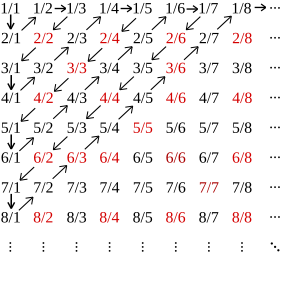Countable set facts for kids
A countable set is a group of things (called elements) that you can count. Imagine you have a list of items; if you can go through that list and count every single item, then it's a countable set.
For example, a set with just a few items, like your favorite three video games, is countable. Even a set with a hundred items is countable. What's cool is that some sets with an infinite number of items can also be counted! This means you could, in theory, list every single item without missing any, even if it takes forever. Sets like this are called countably infinite. The idea of countable sets was first described by a mathematician named Georg Cantor.
Contents
What Are Countable Sets?
A countable set is any set where you can match each item in the set to a natural number (1, 2, 3, and so on). This means you can give each item a unique "number in line."
- Finite sets: These are sets with a limited number of items. No matter how many items there are, as long as it's a specific number, it's countable. For instance, all the students in your school form a finite and countable set.
- Infinite sets: Some infinite sets are also countable. This might sound strange because you can't actually finish counting an infinite set. But if you can find a way to list every item without missing any, then it's considered countable.
Examples of Countable Infinite Sets
Let's look at some examples of infinite sets that are countable:
- Natural Numbers: These are the numbers we use for counting: {1, 2, 3, 4, ...}. You can easily list them one by one.
- Whole Numbers: These include zero and all the natural numbers: {0, 1, 2, 3, ...}. You can also list these in order.
- Integers: These are all the whole numbers and their negative partners: {..., -3, -2, -1, 0, 1, 2, 3, ...}. To count these, you can list them like this: {0, 1, -1, 2, -2, 3, -3, ...}. This way, you make sure to get to every positive and negative number.
- Square Numbers: These are numbers you get by multiplying an integer by itself: {0, 1, 4, 9, 16, 25, ...}. You can list these in increasing order.
Counting Rational Numbers
The rational numbers are also countable. A rational number is any number that can be written as a fraction (like 1/2, 3/4, or -5/1). Counting them is a bit trickier than counting integers.
You can't just list them like 0/1, 1/1, -1/1, 2/1, because you'd never get to fractions like 1/2. Instead, imagine a big table where the top row lists the numerators (the top part of the fraction) and the left column lists the denominators (the bottom part).
You can then "zigzag" through this table. Start at 1/1, then go to 2/1, then 1/2, then 1/3, then 2/2, then 3/1, and so on. As you zigzag, you'll eventually hit every possible fraction. If you come across a fraction you've already counted (like 2/2, which is the same as 1/1), you just skip it. By doing this, you create an endless list that includes every rational number. This shows that the set of rational numbers is countable.
When Counting Doesn't Work
Not every set can be counted this way. For example, if you tried to count integers by listing all the positive ones first (0, 1, 2, 3, ...) and then the negative ones (-1, -2, -3, ...), you would never actually reach -1. This doesn't mean integers are uncountable, but it shows that the counting method matters!
Some sets are truly uncountable. For example, the set of all real numbers (which includes numbers like pi or the square root of 2, not just fractions) cannot be counted. No matter how you try to list them, you will always miss an infinite number of real numbers.
Related pages
See also
 In Spanish: Conjunto numerable para niños
In Spanish: Conjunto numerable para niños


